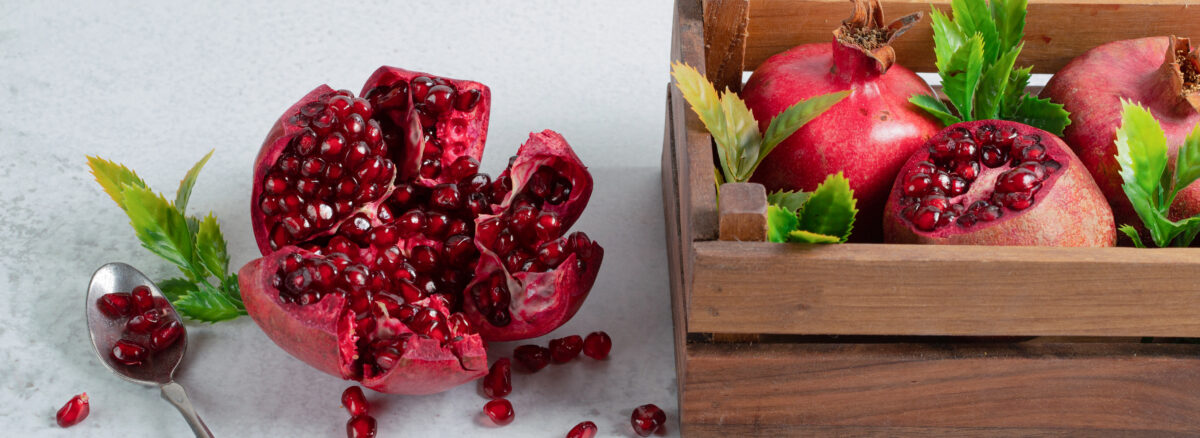DADIM : Pomegranate
The pomegranate is known as a superfood. Their gems like seeds (arils) have been utilized for restorative purposes for centuries. Pressed with ground-breaking cell reinforcements and nutrients, this ruby-red organic product has been demonstrated to be a fix for pretty much any disease.
Botanical name :Punica granatum Linn.
Family: Punicaceae
Classical name :Dadima
Sanskrit name:Dadima, Dantabija, Lohitapushpaka, Koraka.
Varieties: - There are two varieties of fruit in texts of the materiamedica (nighantu).
1. Sweet (swadu or madhuradadima)
2. Acid or sour (amladadima)
Besides the varieties based on taste , the several kinds of fruits are available known for their particular regions or localities of fruits production being one of the esteemed popularly edible market fruits.
In addition, the wild as well as cultivated varieties of fruits are prevalent, as the forests in hilly regions also produce smaller variety fruits.
Rasa :-Madhura, Kashaya, Amla.
Guņa :-Laghu, Snigdha.
Virya :-Anushna
Vipaka:- Madhura (madhurajati-sweet variety), Amla (amlajati-sour variety).
Doshakarma :Tridosha (madhuraphala-sweet fruit),
Kaphavatashamaka-pittala (amlaphala-sour fruit).
· Therapeutic Uses:-
This plant is a well-known fruit-source (Dadima or Anara, the pomegranate) as well as an effective herbal drug therapeutically used in medicine.
· The juice of the fresh leaves and young fruits is given in dysentery. Juice of the leaves and flowers is a styptic; the paste of the leaves is locally applied in conjunctivitis.
· As an anthelmintic medicine with efficiency, the bark of the stem and roots, are commonly used. The root bark is preferred for this purpose, as it contains an alkaloid pumice is greater quantity than the stem-bark which comparatively yields less chemical substance considered active anthelmintic being highly toxic to tapeworms; the fresh bark is preferred then bark in dried state for its use in treatment of worms and allied ailments. It is anthelmintic, astringent, cardiac and cooling, diuretic, expectorant, refrigerant and supportive.
· It is useful in cough and cold, diarrhea and dysentery, dropsy, heart tonic. The drug increases seminal flow and checks bleeding from nose, as in nasal hemorrhage, the flowers are specifically useful.
· This herbal drug is specific for worms especially tapeworms affections; the dried pericarp or rind of the fruit possesses anthelmintic properties in particular.
· The seeds obtained from the fruits, especially from wild sources (plant is occurring wild in warm valleys in many parts of the outer West Himalaya) are sold as anardana (also anardana from cultivated fruits of good quality).
· Market drug anardana, the dried seeds of obtained from fruits, is employed in food items as well as medicinal preparations. Seeds are commonly used as a souring agent for food or edible items such as chutney, pickle (sour dishes), syrups and other similar refrigerant, taste and food or dietetic recipes having domestic utility.
· The fresh juice of the fruit (seeds are actually used) is used as an ingredient of cooling, refrigerant and stomachic mixtures of some medicines for the dyspepsia, loss of appetite and, other stomach troubles and also for common gastrointestinal disorders.
· The unripe fruit is a good appetizer and tonic, astringent to the bowels, aphrodisiac, they are helpful to cure biliousness, tridosa vitiation, thirst, burning sensation of the body, fever, heart disease, sore throat and stomatitis.
· The rind of the fruit is anthelmintic; it is useful in diarrhea and dysentery.
· The bark of the plant is astringent; it is used in piles, prolapse and colic. The flowers are styptic to the gums; they check vomiting, useful in biliousness, sore eyes, ulcers sore throat; they are applied in hydrocele; they are vulnerary. The unripe fruit lessens inflammation and the fruit is useful in keratitis.
· The ripe fruit is sweet, tonic, laxative, diuretic, fattening, they enrich the blood; they allay thirst, they are used in sore throat, sore eyes, brain disease, spleen complaints, chest troubles, scabies, bronchitis and earache; the seeds are astringent to the bowels; enrich the blood; and they are used in vomiting, sore eyes, biliousness, scabies, liver and kidney disorders.
· The dried bark of the stem (trunk) and the roots are also considered to have anthelmintic properties. The bark and fruit combined with other drugs are prescribed for the treatment of snake-bite; and bark is also prescribed for scorpion-sting.
· Fruits are useful in the ailments of brain and psychological complaints. They are useful in anemia, general debility, fever and allied complaints, especially fruit (seeds) juice is given for recovering the normalcy. The fruits are recommended as wholesome (pathya) article for patients in certain diseases.
· Parts used- Fruit-seeds, Fruit-pericarp, Roots bark.
· Dose
Fruit juice 12-60 gms.
Bark decoction 40-80 gms.
· Formulations (yoga):- Dadimashtakachurna, Dadimadichurna, Dadimadyaghruta, Dadimadyataila, Dadimacatuhsama.
Classical Groups:- (gana) Hrudya, Chardinigrahana (Caraka), Parusakadi (Sushruta).


